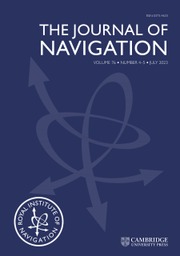Article contents
The Evaluation of Aircraft Collision Probabilities at Intersecting Air Routes
Published online by Cambridge University Press: 23 November 2009
Extract
In this article formulas useful for the calculation of aircraft mid-air collision probabilities at intersecting air routes are developed. The aircraft overlap density, a key parameter in the calculation, is expressed as a function of the intersection angle of air routes, aircraft speeds, the nominal separation, and parameters in the position-error distribution. Two representative probability models for position errors are used to illustrate the computational procedures suggested. A method of approximation over large navigation systems is also proposed.
The calculation of aircraft mid-air collision probabilities is an important step in the design of air-route structure and is a key element in the specification of separation standards and minimum requirements of facilities reliability and accuracy. A thorough analysis of collision probabilities for long-range parallel air routes over oceanic areas was reported by P. G. Reich in three research documents and in a series of papers published in this Journal in 1966. Analysis of collision probabilities at intersecting air routes typical in off-shore and continental areas, however, has not been fully explored to date. The only direct reference available on this subject appears to be the work by Bellantoni,7 in which a collision problem was formulated in the three-dimensional space and was apt to deal with airport terminal landing or take-off situations. For circumstances where horizontal linear air routes intersect one another at preassigned positions, the analysis provided by Bellantoni needs to be simplified and refashioned for use in extensive applications.
- Type
- Research Article
- Information
- Copyright
- Copyright © The Royal Institute of Navigation 1981
References
REFERENCES
- 45
- Cited by


